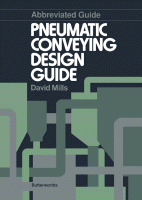Browse content
Table of contents
Actions for selected chapters
- Full text access
- Book chapterAbstract only
Abbreviated Guide
Pages 1-26 - Book chapterNo access
Appendix
Pages 27-40 - Book chapterNo access
Index: Pneumatic Conveying Design Guide
Pages 41-72 - Book chapterNo access
Index: Abbreviated Guide
Pages 73-81
About the book
Description
Abbreviated Guide: Pneumatic Conveying Design Guide describes the selection, design, and specification of conventional pneumatic conveying systems. The design procedure uses previous test data on the materials to be conveyed. The book also discusses system economics, operating costs, the choice of appropriate components or systems, system control, and system flexibility. The design system involves the type of conveying system for installation, the pipeline parameters, and also the plant components. System selection covers the properties of the material to be conveyed, plant layout, material properties, as well as whether an open system or a closed system is more appropriate. In pipeline design, the engineer should consider the bore of the pipeline, the air requirements in terms of delivery pressure and volumetric flow rate. Based on this data, he can determine the rating of the air mover to achieve the optimal material flow rate. From the pipeline design study, the engineer can then evaluate all the necessary operating parameters at each pipeline bore to identify plant component specifications. He can then compute for the costs of the components and operating costs of the system. Engineers, technicians, and investigators involved in industrial pneumatic conveyance will find the book highly useful.
Abbreviated Guide: Pneumatic Conveying Design Guide describes the selection, design, and specification of conventional pneumatic conveying systems. The design procedure uses previous test data on the materials to be conveyed. The book also discusses system economics, operating costs, the choice of appropriate components or systems, system control, and system flexibility. The design system involves the type of conveying system for installation, the pipeline parameters, and also the plant components. System selection covers the properties of the material to be conveyed, plant layout, material properties, as well as whether an open system or a closed system is more appropriate. In pipeline design, the engineer should consider the bore of the pipeline, the air requirements in terms of delivery pressure and volumetric flow rate. Based on this data, he can determine the rating of the air mover to achieve the optimal material flow rate. From the pipeline design study, the engineer can then evaluate all the necessary operating parameters at each pipeline bore to identify plant component specifications. He can then compute for the costs of the components and operating costs of the system. Engineers, technicians, and investigators involved in industrial pneumatic conveyance will find the book highly useful.
Details
ISBN
978-0-408-04731-9
Language
English
Published
1990
Copyright
Copyright © 1990 Elsevier Ltd. All rights reserved.
Imprint
Butterworth-Heinemann
